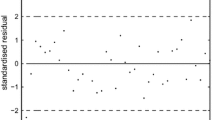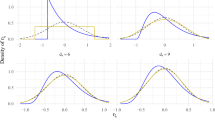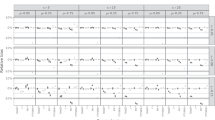Abstract
The estimation of model parameters in structural equation models with polytomous variables can be handled by several computationally efficient procedures. However, sensitivity or influence analysis of the model is not well studied. We demonstrate that the existing influence analysis methods for contingency tables or for normal theory structural equation models cannot be applied directly to structural equation models with polytomous variables; and we develop appropriate procedures based on the local influence approach of Cook (1986). The proposed procedures are computationally efficient, the necessary bits of the proposed diagnostic measures are readily available following an usual fit of the model. We consider the influence of an individual cell frequency with respect to three cases: when all parameters in an unstructured model are of interest, when the unstructured polychoric correlations are of interest, and when the structural parameters are of interest. We also consider the sensitivity of the parameters estimates. Two examples based on real data are presented for illustration.
Similar content being viewed by others
References
Andersen, E.B. (1992). Diagnostics in categorical data analysis.Journal of the Royal Statistical Society, Series B, 54, 781–791.
Beckman, R.J., Nachtsheim, C.J., & Cook, R.D. (1987). Diagnostics for mixed-model analysis of variances.Technometrics, 29, 413–426.
Cook, R.D. (1986). Assessment of local influence (with discussion).Journal of the Royal Statistical Society, Series B, 48, 133–169.
Goetz, A. (1970).Introduction to differential geometry. Reading, M.A.: Addison Wesley.
Hansen, E.J. (1978).The distribution of living conditions: Main results from the welfare survey (in Danish). Copenhagen: Teknisk.
Jöreskog, K.G. (1994). On the estimation of polychoric correlations and their asymptotic covariance matrix.Psychometrika, 59, 381–389.
Lawrance, A.J. (1988). Regression transformation diagnostics using local influence.Journal of the American Statistical Association, 83, 1067–1072.
Lee, S.Y., Poon, W.Y., & Bentler, P.M. (1990). A three-stage estimation procedure for structural equation models with polytomous variables.Psychometrika, 55, 45–51.
Lee, S.Y., Poon, W.Y., & Bentler, P.M. (1995). A two-stage estimation of structural equation models with continuous and polytomous variables.British Journal of Mathematical and Statistical Psychology, 48, 339–358.
Lee, S.Y., & Wang, S.J. (1996). Sensitivity analysis of structural equation models.Psychometrika, 61, 93–108.
Muthén, B. (1984). A general structural equation model with dichotomous, ordered categorical, and continuous latent variable indicators.Psychometrika, 49, 115–132.
Newcomb, M.D., & Bentler, P.M. (1988).Consequences of adolescent drug usse: Impact on the lives of young adults. Newbury Park, CA: Sage.
Poon, W.Y., & Lee, S.Y. (1987). Maximum likelihood estimation of multivariate polychoric correlation coefficients.Psychometrika, 52, 409–430.
Shi, L. (1997). Local influence in principal component analysis.Biometrika, 84, 175–186.
St Laurent, R.Y., & Cook, R.D. (1993) Leverage, local influence and curvature in nonlinear regression.Biometrika, 80, 99–106.
Stoker, J.J. (1969).Differential geometry. New York: Wiley.
Tanaka, Y., Watadani, S., & Moon, S.H. (1991). Influence in covariance structure analysis: with an application to confirmatory factor analysis.Communications in Statistics, Series A, 20, 3805–3821.
Thomas, W., & Cook, R.D. (1990). Assessing influence on predictions in generalized linear models.Technometrics, 32, 59–65.
Author information
Authors and Affiliations
Corresponding author
Additional information
The work described in this paper was partially supported by a Chinese University of Hong Kong Postdoctoral Fellows Scheme and a grant from the Research Grants Council of the Hong Kong Special Administrative Region, China (RGC Ref. No. CUHK4186/98P). We are indebted to P.M. Bentler and M.D. Newcomb for providing the data set, Michael Leung for his assistance, and the Editor and the referees for some very valuable comments.
Rights and permissions
About this article
Cite this article
Poon, WY., Wang, SJ. & Lee, SY. Influence analysis of structural equation models with polytomous variables. Psychometrika 64, 461–473 (1999). https://doi.org/10.1007/BF02294567
Received:
Revised:
Issue Date:
DOI: https://doi.org/10.1007/BF02294567




